Awareness and Utilization of Emergency Contraception Among Female High School Students in Southeast Ethiopia
Introduction
Background
Emergency contraception (EC) is contraceptive methods that
can be used by women within five days following unprotected
intercourse to prevent an unplanned pregnancy.EC provide a
unique opportunity for preventing pregnancy after unprotected sex
that no other contraceptive method can provide. It is as effective
as 75-99% if taken within recommended time frame [1]. The
capability of EC addressing the problems of unintended pregnancy
in adolescent and young people posits the service one of the most
crucial remedies in contraceptive arena for the fact that the sexual
activity during adolescence is usually infrequent, unplanned
and unprotected [1,2]. Moreover, the steady increase in school
attendance rates in developing countries has given the chance for
large proportion of young people to become sexually mature while
they are at secondary school or earlier. When unintended pregnancy
occurred to young girls they forced to dropout from school or
goes for unsafe abortion [3]. In connection to the magnitude of
the problems, nearly 210 million pregnancies occur each year
globally. About 40% of these pregnancies were unintended. Of
these unintended pregnancies 50% ended in abortion. About 42
million induced abortions each year, nearly 20 million abortions
are unsafe. This represents 13% of maternal death. More than 95%
of unsafe abortions occur in developing countries and nearly half of
maternal deaths in sub-Saharan Africa were due to unsafe abortion
[4,5]. In most developing countries complication of pregnancy and
childbirth are a leading cause of death and disability among women
of reproductive age. Teenage girls are at double risk of dying from
pregnancy and birth complication than women over 20 years. This
risk is five times higher for those girls under 15. In sub-Saharan
Africa nearly 60 % of women who have unsafe abortion are younger
than 25years of age, and 25% are teenagers [5,6].
The magnitude of abortion related morbidity and mortality
are highest among young unmarried women in developing
nations. For instance, in Uganda among women hospitalized with
abortion-related complications, about two-thirds were 15 to 19
years old, two-thirds were students, and 80 % of them had never
been married. In Nigeria Hospital-based studies have shown that
up to 80% of patients with abortion-related complications are
adolescents. In Ethiopia abortion accounts 60% 0f gynecological
admission and girls under age 15 are three times more likely to
end their pregnancies in abortion as compared to those ages 20-24.
According to the 2011 Ethiopian Health and Demographic Survey
(EDHS), 12% of young women age 15–19 have already begun
childbearing [1,6,7]. Study conducted in Nepal among youths of
15-24 years in higher secondary and undergraduate students, the
level of awareness of EC found to be 47%. But, only few mentioned
the correct definition (17.02%) and consuming time (9.58%) of
emergency contraceptive pills (ECP). Similarly, a study done in Dar
Es Salaam, Tanzania, revealed that 57% of the respondents aware
of ECP and only 14% had used it. A study conducted in Dessie,
Ethiopia, on knowledge, attitude and practice (KAP) of emergency
contraception among female college students disclosed that among
those who had history of having sexual intercourse 78.3% of
them faced unwanted pregnancies and 43.3% of these unwanted
pregnancies resulted in abortion.
Of the respondents who had heard about emergency
contraception only 15.4% of them made use of it. A study conducted in Jimma town, south west Ethiopia among female high school
students revealed that (40.5%) had heard about EC. From those
who heard of EC, 27% of the respondents mentioned the correct
recommended timing for oral pills of emergency contraception [8-
11]. Currently, there are more adolescent girls in school than ever in
our country. It is imperative that these girls have to complete their
secondary education and beyond without any risk of unwanted
pregnancies. EC is one of the known contraceptive methods to avert
such problem. Knowing the level of awareness and utilization of EC
by school adolescents is the first step of all the intervention to be
implemented to protect adolescents from unintended pregnancy.
Though few studies have been conducted on EC, they were focused
only on students of higher institutions in big cities of the country.
However, there are few or no scientific based research has been
conducted so far in a district town like Dodola in which students
come from both the town and rural areas around it. Thus, this study
was conducted with an intention to determine awareness and
utilization of EC and factors affecting the awareness and utilization
of EC among Dodola female high school students. The study finding
aimed to shape the local intervention by equipping district and
zonal health leaders and service providers. Furthermore, the
finding of the study will enable the comparison of service utilization
within the region and outside; hence area specific interventions can
be planned.
Methods and Materials
Study Setting
Dodola is located in southern part of Ethiopia, Oromia national regional state, west Arsi Zone at distance of 320km from the capital city Addis Ababa and 75km from Shashemene, the zonal center. According to 2014\15 woreda base plan, Dodola has total population 30,238 of which 14,917 males and 15,321 females. There are two administrative kebeles. With respect to some social services, the town has one district hospital and two health posts owned by the government. Moreover, it has one higher, four medium, six lower clinics, one pharmacy and eleven drug stores owned privately. There are three elementary, one high school and one preparatory public school.
Study Design
The study employed an institutional based cross-sectional quantitative study design with internal comparison carried out among female high school students in Dodola town, Oromia regional state in January 2016.
Population
Source Population: The source population of the study includes all high school female students in Dodola town who were enrolled in 2015/16 academic year.
Sample Size
The sample size was determined using the following assumptions: for the first study objective, expected prevalence of level of awareness of EC (64.48%) [12], Level of confidence 95%, and 5% margin of error (d=0.05). Formula for calculating the sample size n= [(Ζ 2) ×P (1 – P)/D2]. Considering design effect of 1.5 and using correction formula for finite population (N=1123female students) by adding nonresponse rate of 10% the final sample size=395. Following similar assumption and formula by taking the prevalence of EC utilization to be (25%) [11] sample size for the second objective was 344. However, when adjusted for sexually active students, the sample size increased to 773. By comparing two sample sizes, the largest 773 was taken as final sample size to ensure the maximum sample size (Figure 1).
Sampling Technique
The schools were stratified in grade levels (9th& 10th). Respondents from each section were selected by simple random sampling using school enrollment list as sampling frame. Proportional distribution of sample was assigned to the respective schools, grades and sections based on the enrolment data for the academic year (Figure 2).
Data Collection Procedure & Quality Management
The data collection instrument was an anonymous selfadministered structured questionnaire. The questionnaires initially prepared in English and translated to Afan Oromo, and again back to English to ensure consistency and validity by language experts. Five percent of the samples were pretested before the actual data collection and some questions were amended. Training was given for data collection facilitators and supervisors for two days before the pretest and for a day after the pretest. The questionnaires were distributed to randomly selected students. Once the students finished filling the self-administered questionnaires, they had deposited them in a designated box, as informed earlier, to assure their anonymity. The overall data collection process was supervised by Principal investigator.
Operational Definition
Utilization of Emergency Contraceptives: Ever practice of emergency contraceptives.
Data Processing and Analysis
The collected data ware checked for their completeness and consistency and entered into SPSS version 20 for analysis. Data was summarized and organized using appropriate descriptive measures; frequencies and percentages of the responses were calculated. Associations between variables were assessed by using Odds Ratio with 95% Confidence Interval. First all variables were analyzed with bivariate analysis, then variables with p-value less than 0.25 were considered in Multivariate logistic- regression. Statistical association was declared at p-value less than 0.05 both in Bivariate and Multivariate logistic-regression.
Results
Socio-Demographic Characteristics of the Study Population
Seven hundred nineteen of the total 773 school adolescents were completed the survey questionnaire. Fifty four (6.98%) of the questionnaire were discarded due to incompleteness. Majority of the respondents 452(62.9%) were aged between 13-15 years with the mean age of 15.46 year with standard deviation (SD) of 1.76. About (51.6%) were attending grade nine and most of the respondents (96.2%) were single during the survey. The dominant religion was Islam (73.3%) followed by Orthodox (18.8%) and the majority were from Oromo ethnic group 578(80.4%).
Majority of the respondents 692(96.2%) had ever heard about modern contraceptives but only 304(42.3%) had ever heard the existence of EC before the survey. From those who ever heard of EC, 65.8% of them said oral pill should be used within 72hrs (3days) and 20.4% of them said Intra uterine Contraceptive Device (IUCD) should be used within 120hrs (5days) after unprotected sex to prevent unintended pregnancy. Of those who heard of EC, 207(68.1%) respondents said EC should be used after unprotected sex whereas 90(29.6%) of them said it should be used after unwanted pregnancy (Table1).
Table 1: Socio demographic characteristics of female high schools students of Dodola town, January 2016.
Utilization of Emergency Contraceptive
From the total 275 sexually active students only 27(9.8%) of them had used EC. Oral pill was the only methods utilized as EC. About 21(77.8%) of users took the first dose within 72hours after unprotected sexual intercourse and 17(63%) of them were recommended to use EC by their female friends. More than eighty five percent of EC users had used it two and more times. (Table 2).
Table 2: Awareness and utilization of female high schools students towards emergency contraception in Dodola town, January 2016.
Determinant Factors Related to the Awareness and Practice of Emergency Contraceptives
During bivariate logistic regression, age of respondent, having TV, having radio, having constant pocket money, drinking alcoholic beverage, chewing chat, mothers’ educational status and place of primary education showed significant association with the awareness of EC. Similarly, age of respondent, grade level, having TV, having constant pocket money, drinking alcoholic beverage and mothers’ educational status showed association with utilization of EC when analyzed using bivariate logistic regression. However, multivariate logistic regression analysis indicated that, age >15years (AOR= 2.92(95% CI(1.99,4.26)], having radio(AOR= 4.42 (95% CI(2.64,7.38)], having TV(AOR= 1.99(95% CI(1.19,3.30)] and chewing chat(AOR= 3.08 (95% CI(1.39,6.82)]showed statistically significant association with the awareness of EC (Table 3). Likewise, only age >15years (AOR= 3.52(95% CI(1.04,1.92)], having constant pocket money(AOR= 3.52(95% CI(1.15,10.75)] and mothers’ educational status(AOR= 4(95% CI(1.32,12.09)] were remained the real predictors of EC utilization when adjusted to the confounders with multivariate analysis (Tables 3 & 4).
Table 3: Bivariate and multivariate logistic regressions of selected variables in relation to awareness of EC among female high school students in Dodola town; January 2016.
Table 4: Bivariate and multivariate logistic regressions of selected variables in relation to Utilization of EC among female high school students in Dodola town; January 2016.
Discussion
Unintended pregnancy that usually followed by unsafe abortion
is a major reproductive health challenge in developing countries.
This RH risk is higher among young females than adult women(4).
Nevertheless, unwanted pregnancy resulting from unprotected sex
can be prevented by the proper use of EC. The result of this study
showed that 38.2% of the respondents were sexually active. Forty
percent of sexually active students had history of pregnancy, which
83.6% of those pregnancies were unwanted and 58.7% of unwanted
pregnancy resulted in unsafe abortion. Similar studies in Dessie
and Mekele cities have showen lower prevalence of unintended
pregnancy and unsafe abortion. High rate of unwanted pregnancy
and unsafe abortion in this study than the above two studies may
be due to high awareness and utilization of EC in those studies
than current one which is 70% for Dessie and 90.3% for Mekele [9,13]. When compared to Dodola, the small rural town, the former
two cities are with relative better positions both in health service
accessibilities and information dissemination. This is more or less
similar with studies of Addis Ababa University students 43.5% and
high school students of Jimma town 40.5% [11,14]. But it is lower
than those studies conducted among tertiary students in Nigeria,
college students of Dessie town and Adewa preparatory students
65.3%,69.9%&64.48% respectively [9,13,15]. This discrepancy
could be due to socio-demographic and difference in the education
status of the study population.
This study revealed that, out of sexually active respondents only
9.8% of them were utilized emergency contraceptive methods. It is
more or less similar with research done among youths of Parbat
district, Nepal 8.34% [10]. The finding of this study found to be
lower than study conducted among Tertiary Students in Osun State,
Southwestern Nigeria 32.6%, Mekele preparatory school 53.5%
and Debre Markos University 18.4% [13,15,16]. This might be due
to the age and knowledge difference between university and high
school students. Regarding determinant factors for the awareness
and utilization of EC, the present study found that respondents
whose age is greater than 15 years were about three times more
likely to be aware and utilize EC compared to the age group of
fifteen or less years. The finding is consistent with previous studies
conducted in Addis Ababa, Mekele, Haramaya and Dessie which
reported older age groups were more likely to be aware and practice
EC when compared to younger age groups [9,17,13-14]. This might
be due to younger youth may be less concerned about unwanted
pregnancy and EC as they have not yet started or newly joining to
sexual activity. The other possible explanation for this could be as
age increases the education level and knowledge of sexual matters
may increase.
This study found that respondents who had constant pocket
money were more than three times more likely to practice EC than
those who had no pocket money. This may be explained by having
constant pocket money may help students to decide by themselves
to buy and use EC if they faced unprotected sexual intercourse
without the consent of others. Moreover, the more they are financial
sufficient, the more that they have freedom to practice sex. This is in
agreement with the study conducted in Hawassa University about
the patterns of risky sexual practice among students [18].
Conclusion and Recommendation
The study finding showed low awareness and utilization of emergency contraceptive among female high school students. This may be among the reasons for high rate of unintended pregnancy and unsafe abortion among the study population. Awareness and utilization of female high school students on EC are affected by a range of circumstances. Given the high rate of unintended pregnancy and unsafe abortion reported by the study participants; the academic institution with the health sector should take measures that can increase awareness of students and ensure easy availability of EC at school level or adolescent and youth friendly clinic in the nearby.
For more
Articles on : https://biomedres01.blogspot.com/
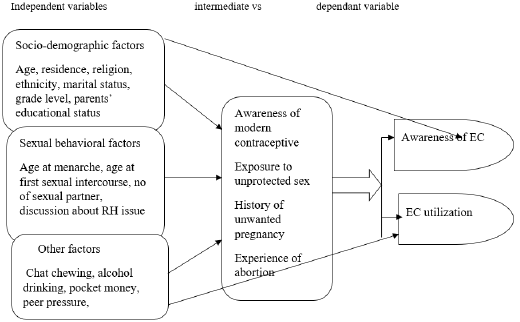
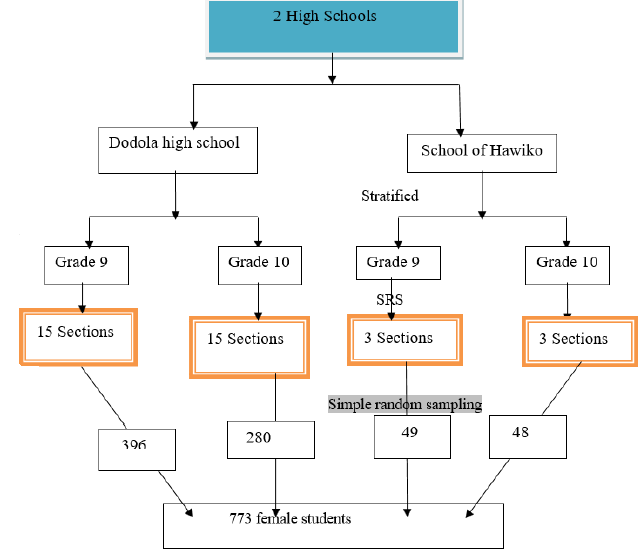
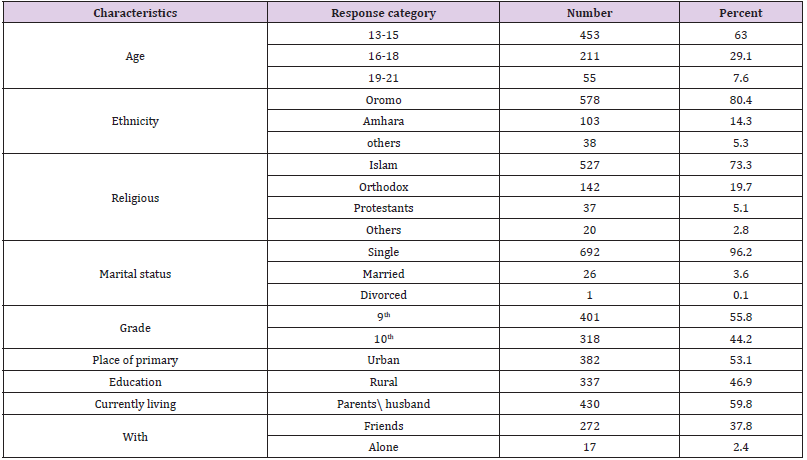
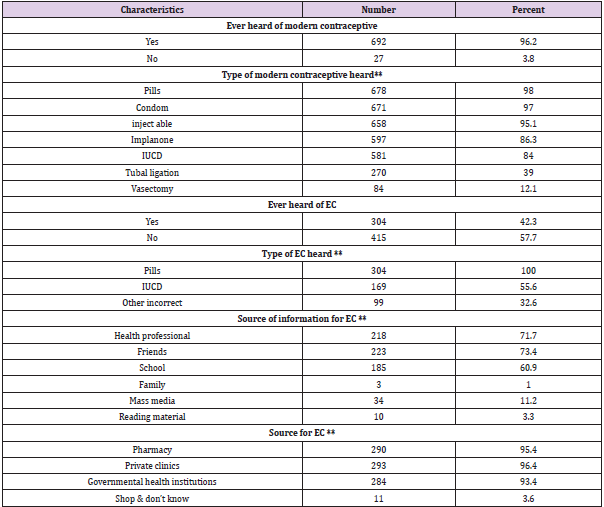
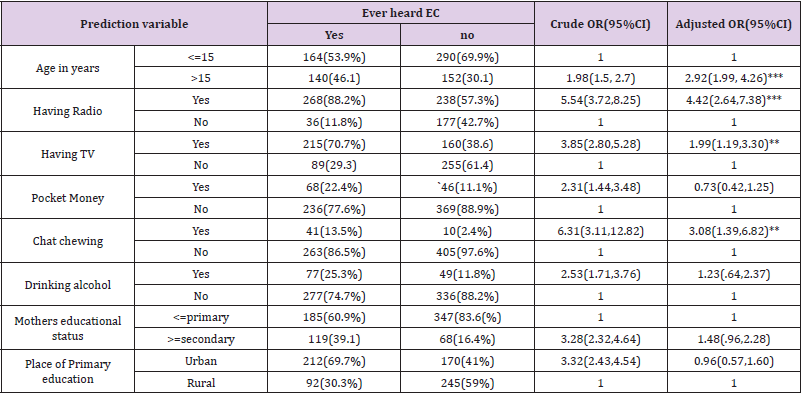
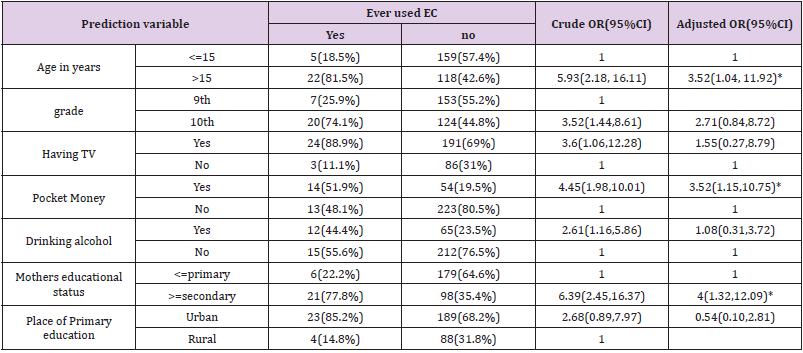


No comments:
Post a Comment
Note: Only a member of this blog may post a comment.